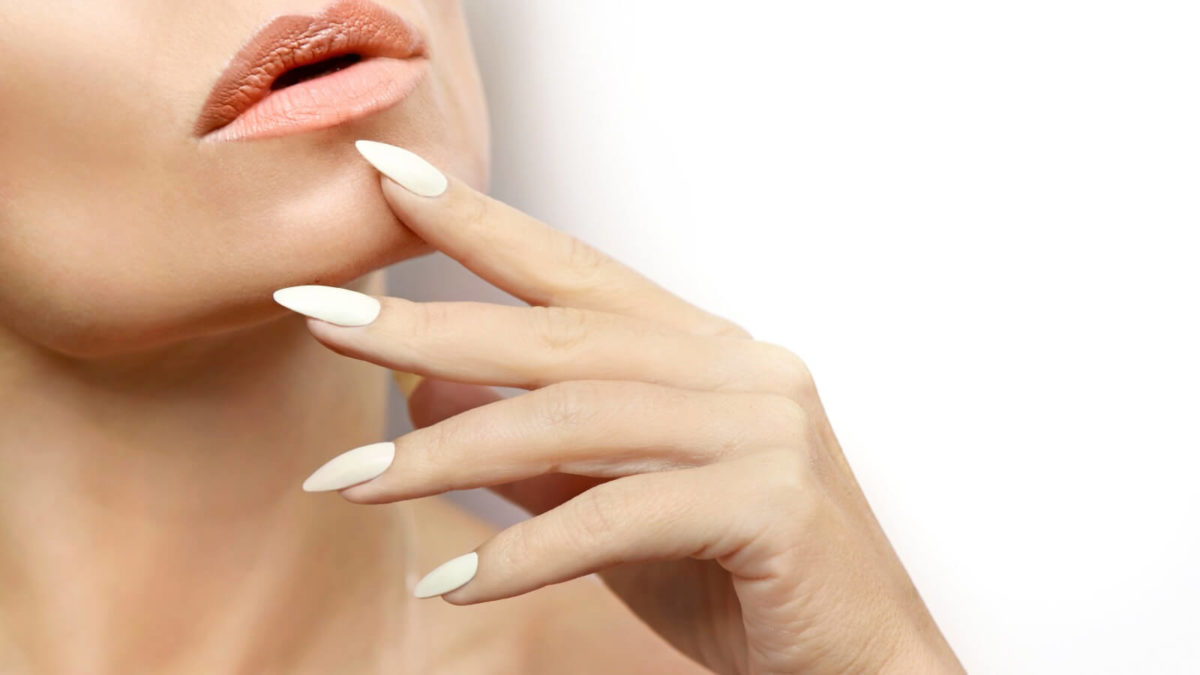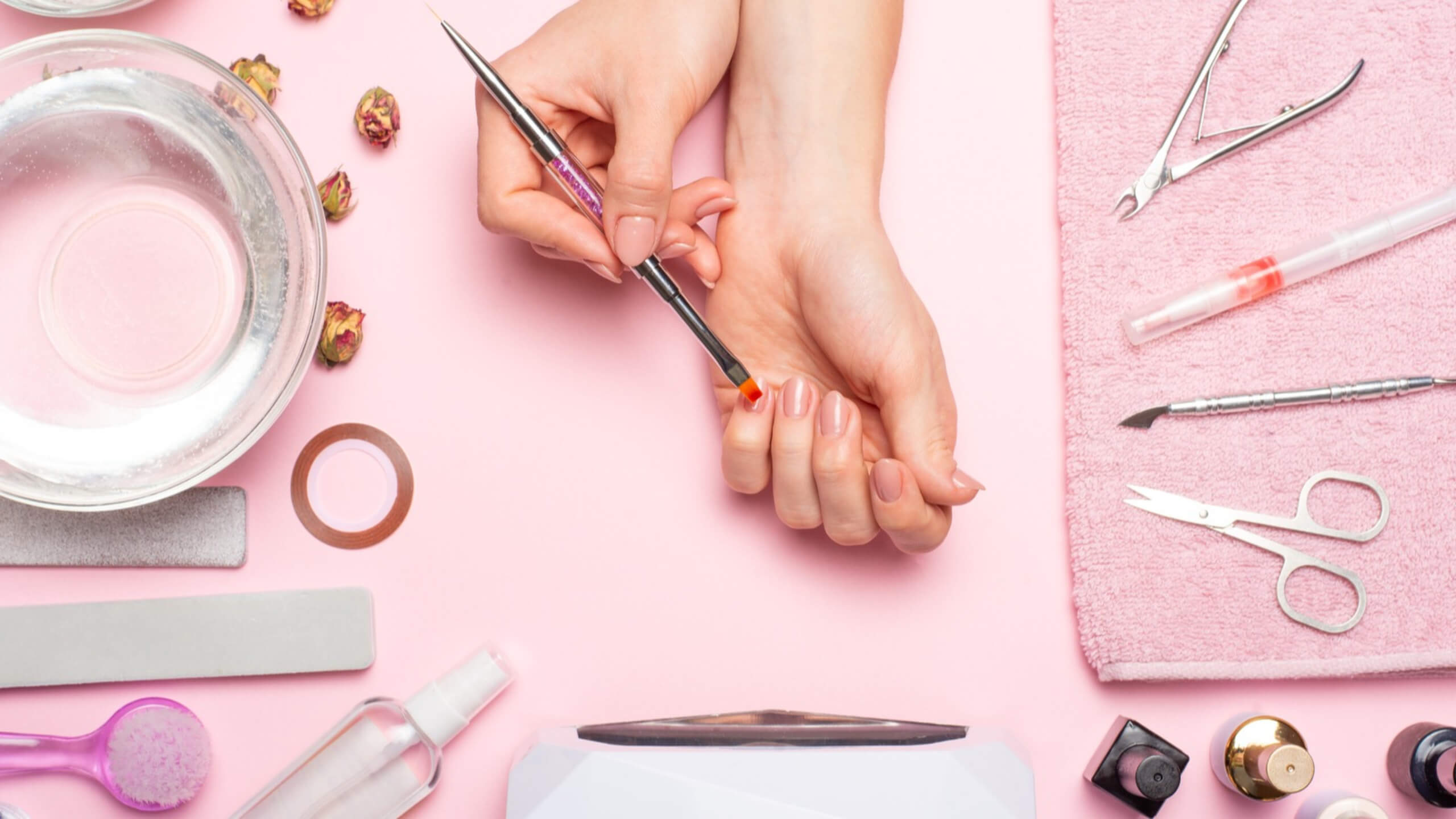Saying that nail art is having a moment right now would be a serious understatement. Whether in real life, on the runways, or via social media, it seems like anyone and everyone has dramatic gel extension or acrylic nails covered in eye-catching nail art.
You have a few options if you’re interested in rocking your own set of talons. The major ones are gel extension (gelx) or acrylic nails. Both types of extensions will give you longer, stronger nails that can be decorated with any design imaginable. Read on to learn the pros and cons of each technique, so you can decide which option will work best for you.
In this article:
- What are gel nail extensions?
- What are acrylics?
- Gel nail extensions vs. acrylics
- FAQ’s
- Bottom Line: Which nail extensions should you get?
What are gel nail extensions?
| What we love | What we don’t love |
| Last up to four weeks | Difficult to get refills, especially with pre-made soft gel systems |
| Lightweight material is less damaging to natural nails | More expensive when done in the salon |
| Easy to apply by yourself at home | Salon appointments may take longer due to curing time |
| Pre-made extensions result in a more consistent shape that’s less dependent on the skill of the manicurist | Sometimes lift off easily (compared to acrylics) |
| Removal process isn’t too harsh on the nails | |
| Compatible with many different types of nail art |
Gel nail extensions are a fascinating technology. These extensions are made from a malleable gel that’s molded and sculpted to form a nail extension. It’s then cured under a UV lamp to become hard and durable.
There are a couple of techniques for creating gel nail extensions. In many salons, the nail technicians sculpt gel extensions directly on the client’s nails with the help of nail forms. This process requires intricate skill and artistry.
Recently, nail art brands have developed pre-made extension systems. The most popular is Aprés Gel-X, a hybrid between press-on nails and gel nail extensions. The Gel-X extensions are made of a patented soft gel formula that’s sculpted and cured in advance so the extensions can be applied at home or in the salon with a UV-cured bonding gel. Gel-X extensions last just as long as professional extensions, but they require less skill to apply.
The gel extension material tends to be fairly lightweight, which is why it can be applied safely in one piece from the cuticle to the base of the nail. The process of getting Gel-X extensions often requires curing each individual nail under a UV lamp, which some may find to be time-consuming compared to a typical manicure.
Gel nail extensions usually last two to three weeks, and then you may need either a refill or a brand new set. After three to six refills, you’ll probably want to start fresh with a brand new set. Aprés Gel-X extensions specifically can last up to four weeks, but there’s no refill option available.
What are acrylics?
| What we love | What we don’t love |
| Long-lasting | Often damaging to the nails |
| More affordable than gel nail extensions | Difficult removal process |
| Easy to get refills | Application process may emit a strong odor |
| Expert nail technicians can make them quickly |
You’ve probably heard of acrylic nails, but you may not be familiar with exactly what they are and how the application process works. Acrylic extensions are created directly on the natural nail from a mixture of acrylic powder (polymethyl methacrylate) and a monomer liquid (ethyl methacrylate). For this material to stick to the nail, the manicurist must roughen the natural nail surface with a buffer or Dremel.
Using a brush, the technician will then add liquid to the powder to create a malleable ball. The manicurist might also apply a pre-formed plastic tip to the nails before brushing the ball and forming it directly over the nails to create the extensions.
After about 10 minutes, the mixture hardens on the nail. The technician will use a buffer to shape the extensions, which can kick up a good amount of powder that has a very strong odor. They’ll usually finish off the look by painting the nails with either gel or regular nail polish.
This process results in hard nail extensions that tend to have excellent durability and longevity. Most nail technicians recommend that clients return every two to three weeks for refills. With regular refills, a set of acrylic nails can last anywhere between two and six months (and some technicians even state that their refills can keep a set of acrylics going indefinitely). Keep in mind that the longevity of acrylics will heavily depend on keeping the same shape and length and whether you break a nail or two. In the event of a style change or missing nails, a new set may be required.

Gel nail extensions vs. acrylics
To really understand which option will suit you best, we compare gel extensions and acrylic nails more directly using a variety of key factors:
Longevity
If your priority is having long-lasting nail extensions, acrylics have the edge. They tend to have better adherence, while gel extensions can sometimes lift off the nails a few weeks after they’re applied. That said, regular refills are a must with both options, and the skill of your manicurist will also have a significant impact on your results.
Nail health
Gel nail extensions are lighter-weight, more flexible, and easier to remove than acrylics, so they’re gentler on the nails. Gel extensions are less likely to cause thinning or brittleness.
In terms of buffing, both nail extensions require some buffing away at the surface of the natural nail plate. Acrylics require slightly more buffing, but with both techniques, the level of damage ultimately depends on how aggressive your technician is. A skilled technician will know how to limit the damage as much as possible no matter which extensions you choose.
Removal
If you want nails that will hold up for ages, acrylics are a safer bet. If you want a one-off that’ll be easy to remove, gel nail extensions are the better choice.
Gel extensions can be buffed and soaked in acetone to remove. With acrylics, on the other hand, the extensions must first be soaked in acetone to soften them up. Only then can you remove them by filing them down, which can be rough on your natural nails.
Cost
At the salon, acrylics are usually the more affordable option, with an initial set typically starting at $50 and refills starting at $40. Gel nail extensions normally start at $60, while refills start at $50. With refills, you can also maintain acrylic extensions for a longer period of time, which keeps costs lower in the long run.
Home use
If you love doing your own nails, you’ll probably have an easier time with gel extensions. Many at-home kits are available, including beginner-friendly Aprés Gel-X and slightly more complex poly-gel systems that require some sculpting. While it’s possible to do acrylic nails at home, too, it can be an extensive process.
FAQs
Are gel extensions healthier than acrylics?
Yes, gel nail extensions are a healthier choice than acrylics, especially if you have brittle nails. This is because gel extensions are lighter weight, so they put less pressure on your natural nails. They’re also easier to remove, which makes them less likely to cause damage.
Why are gel extensions better than acrylic?
Gel extensions aren’t necessarily better, but they do have a few major benefits over acrylics. First, gel extensions are less damaging to natural nails, so they’re a better choice if you’re concerned with nail health. Second, gel extensions are much easier to do at home by yourself, so they can be a better option if you prefer to skip out on the trip to the salon.
What are the healthiest nail extensions?
Gel nail extensions, including both Aprés Gel-X and Biogel, are considered the healthiest. They’re lightweight and easy to remove, putting less strain on the natural nail. But remember, no matter which extensions you choose, removing them correctly is the most important factor for keeping your nails healthy.
Bottom line: Which nail extensions should you get?
Deciding between gel nail extensions and acrylics comes down to a few main factors: the health of your nails, how much money you want to spend, and whether you prefer the nail salon or DIY.
At the salon, acrylics are the more affordable and longer-lasting option, but they can take a toll on your natural nails, especially if your nails are already brittle. Gel extensions are pricier when done at the salon, but they’re less damaging to your nails and easier to remove if you want a one-off experience. If you’re eager to save money, you can always try to do your own gel nails at home.
No matter which extensions you choose, remember that the results also depend on the skill of your manicurist, so select your salon and nail technician wisely!





